Aug. 21st, 2019
I have enjoyed my fair amount of travelling, from spur-of-the-moment road trips through Romania to dog sledding in Canada, but the thought of a cruise never really appealed to me. Until I spent nine days in southern Africa with CroisiEurope Cruises, that is.
CroisiEurope has completely changed my preconceived notions regarding what a cruise could be. Called Southern Africa: Travel to the Ends of the Earth, This all-inclusive, nine-day adventure takes you to four unique countries (so your passport better be ready), which includes three nights in their bespoke luxury lodge in Namibia, three nights on their beautiful African Dream vessel in Zimbabwe, an optional helicopter ride over Victoria Falls, and oh yeah, so many animal sightings that you actually start getting used to seeing elephant herds strolling past you.

Photo Courtesy of Mila Pantovich
Based in Strasbourg, France, family-owned CroisiEurope is pretty impressive. First off, they have been around since 1976 and boast one of the largest fleets of inland water vessels. Secondly, they make each and every ship themselves, meaning that they have built every aspect of their excursions to meet their guests’ needs. Unlike other major cruises, CroisiEurope groups are kept relatively small, with some of the largest ones still keeping it under 200 guests, and the southern Africa trip actually maxes out at 16 people. Because of the size, you can easily jump on this trip solo and make some new friends – or you can just gather 16 of your closest pals and family members to completely take it over.
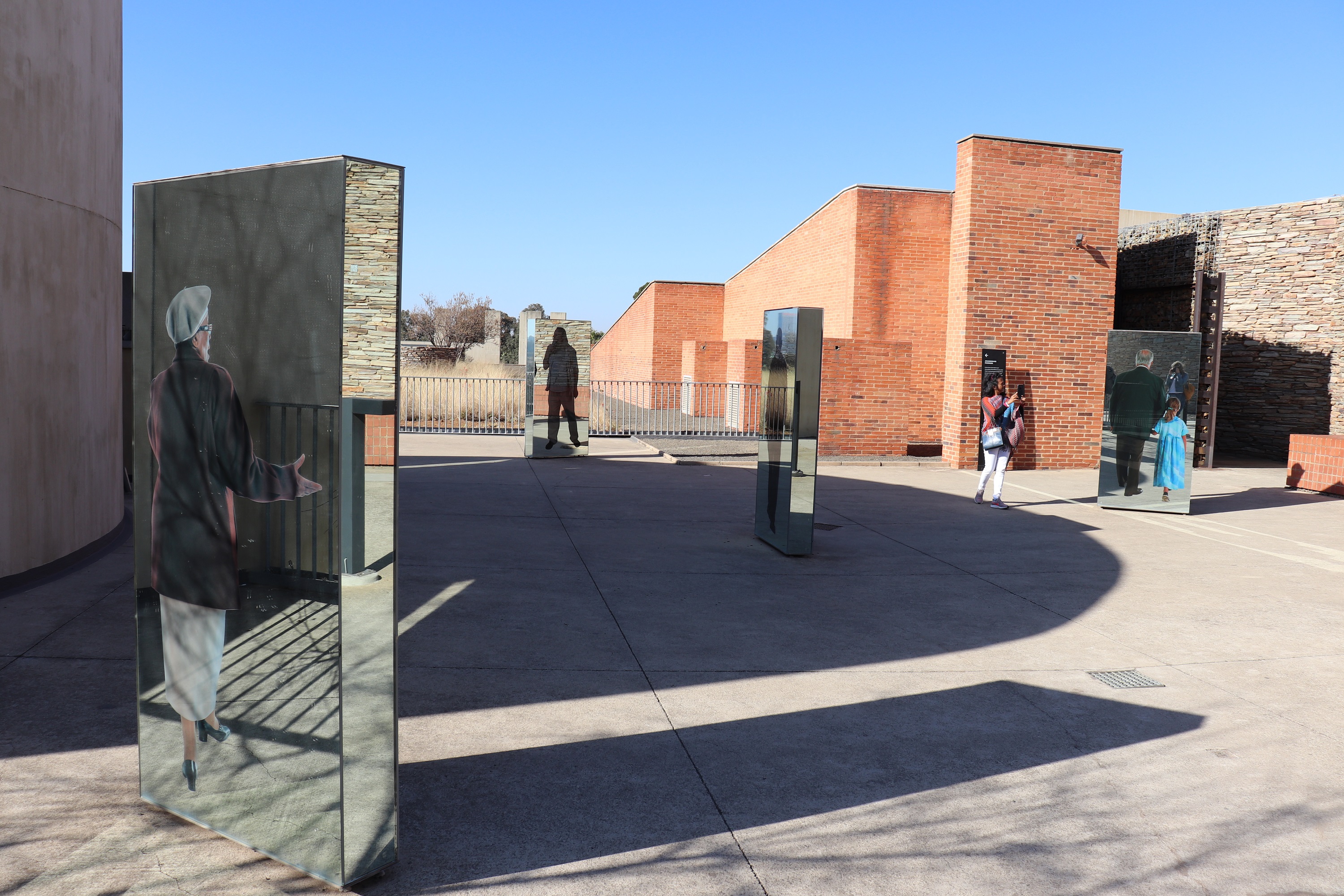
Photo Courtesy of Mila Pantovich
Starting at $7,100 per person, the adventure begins in Johannesburg, South Africa, where on day one you will be taken to the Apartheid Museum. Centering on South African history in the 20th century, this museum is a serious must-visit. After arriving, you are randomly given a ticket that determines which entrance you can use, which reflects the racial segregation that occurred during apartheid, a state-sanctioned system based on racial discrimination. Emotionally overwhelming at times, the museum walks you through the struggle of the majority to overthrow tyranny.
It is also worth noting that after the museum, you will be taken on a quick tour of Soweto, a nearby township that caught the world’s attention in 1976 when police opened fire on 10,000 students engaged in a protest march. You will have the opportunity to visit a memorial dedicated to Hector Pieterson, a South African schoolboy who was killed that day, and to ask as many questions as you want. Soweto is also home to the famous Soweto Towers, which is a popular bungee jumping spot. Also called the Orlando Towers, the structures are left over from a decommissioned coal-fired power station and are now covered in vibrant artwork by local artist Karabo Poppy Moletsane. So, if you find yourself with an extra day at the beginning or end of your journey with CroisiEurope, you can always cross bungee jumping off your bucket list.

Photo Courtesy of Mila Pantovich
Your next adventure takes you to Kasane, Botswana, where you will hop on a private boat to head up the Chobe River, connect to the Zambezi River, and end at CroisiEurope’s Cascades Lodge in Namibia. CroisiEurope has designed this entire trip in a way that maximizes your chances of seeing as many animals as up-close-and-personal as possible. From the moment you land in Botswana to the moment you head home, every day is another opportunity to see something truly remarkable in a very intimate setting. But one of the true highlights is zooming back and forth along the Chobe and Zambezi rivers. Though I would spend a lot of time on these rivers over the next few days, their beauty never failed to astound me. You never know what you will see, from African fish eagles swooping down from overhead to the possibility of a pod of hippos popping up beside you at any moment to elephant herds cooling off on the shore. Even the common reeds that grow on the banks lend an otherwordly beauty to the experience.

Photo Courtesy of Paul Shio
Speaking of those common reeds, they serve to camouflage the only entrance to Cascades Lodge, which is a little boat dock on one end of the private island. Uniquely, the lodge is in the middle of the Zambezi River, which acts as a natural border between Namibia and Zambia. From one side of the small island, you see Zambia, and from the other side, you see Namibia’s Impalila Island, which is home to more than 20 villages.
When you first arrive, you are greeted by the staff with a song and dance before you even get a glimpse of the lodge. Set in the middle of lush trees, the main house looks more like a vacation villa than it does a hotel and that is sort of the point. Featuring an open dining room, living area, full bar and kitchen (which is behind the scenes), the interior is decorated with photography and furniture sourced from Amatuli. There is also a large panoramic terrace outside for dining and lounging, which is where you will enjoy your pre-dinner drinks and snacks while listening to trumpetting hippos in the water below.
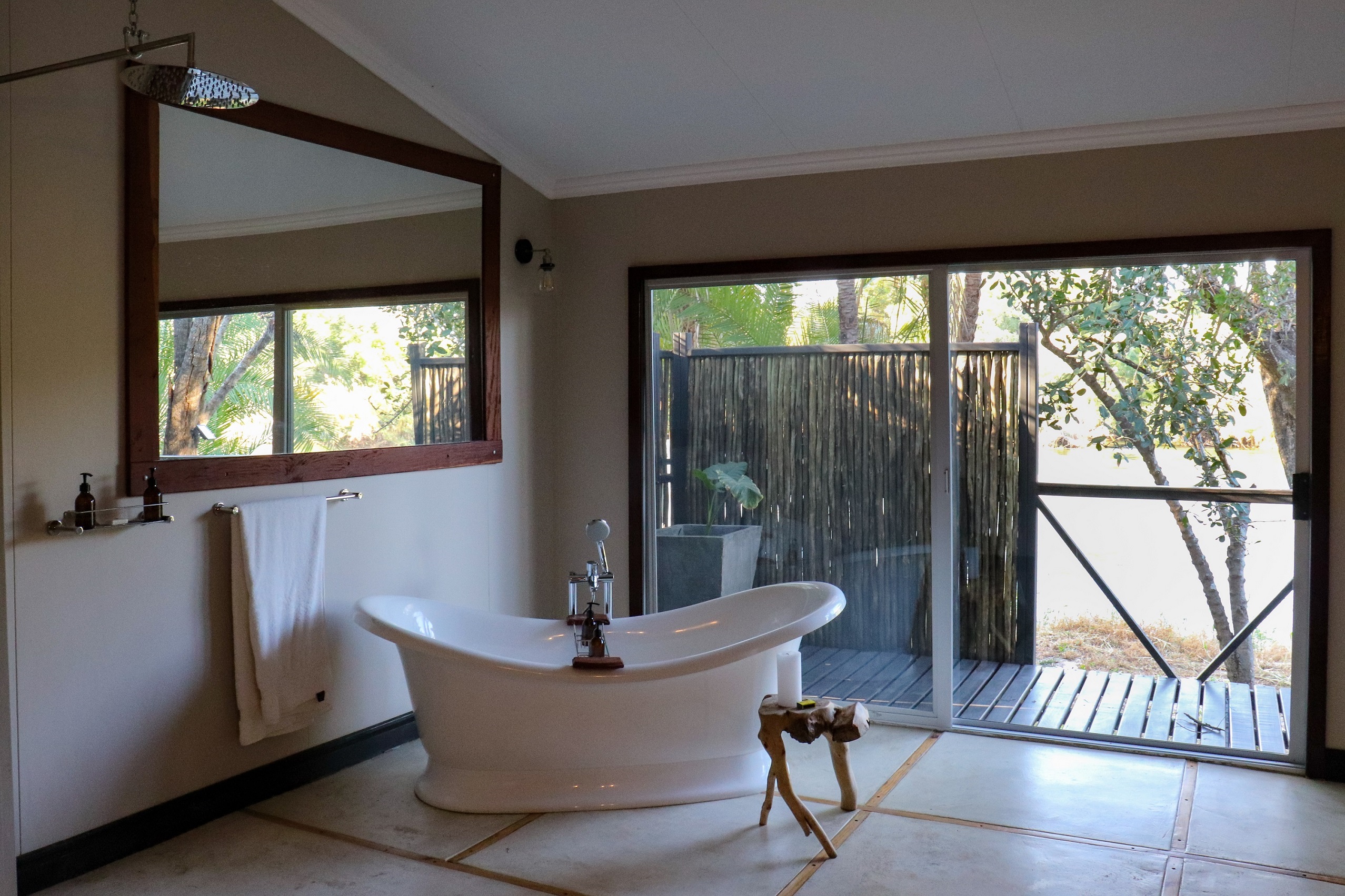
Photo Courtesy of Mila Pantovich
The eight bungalows are exactly what you want from a luxury vacation. Each one boasts a large bedroom, the most perfect bathroom with a to-die-for tub, and a full outdoor deck with a plunge pool and an outdoor shower. Each bungalow is set right on the river (facing Zambia), and while many are built slightly above the shoreline, bungalow one is level with the water and has been known to get some hippo visitors from time-to-time. I was also told that just a few days before my arrival, a herd of elephants appeared on the Zambia shoreline, offering some pretty remarkable views.
The food at the lodge was lovely, with seasonal ingredients prevalent throughout each meal, such as sweet potato and squash. While the carnivores in the group tried out more unique meats like impala, as a vegetarian, I ate my weight in things like deviled egg pasta dishes, vegetable lasagna, and fresh vegetables. Let me also note that the service is impeccable. Everyone working for CroisiEurope is incredibly kind and thoughtful, and you really get to know some of them during your time there. However, as lovely as the lodge is, you don’t actually spend too much time in it, since every morning you leave for a new adventure by 8 am.

Photo Courtesy of Mila Pantovich
The trip’s first safari takes place in the 4,500-square-foot Chobe National Park in Botswana. The country’s very first national park, Chobe is now one of three parks and is known for being home to around 50,000 Kalahari elephants, which are some of the largest in size. Trust me, you will probably see a lot of elephants and depending on the time of year, you might even see countless babies. If you’re lucky, you might even spot some lions and if you are extremely lucky, maybe even a jaguar.
My safari guide for Chobe was incredibly knowledgeable and respectful of not only the animals we encountered, but also the environment. There were a lot of groups in the park that day, which means that there were a lot of safari Jeeps in one area at any given time. While that slightly detracted from the feeling of being out in the open wild, it enabled our guide to chat with others to trade tips on where certain animals might be up ahead.
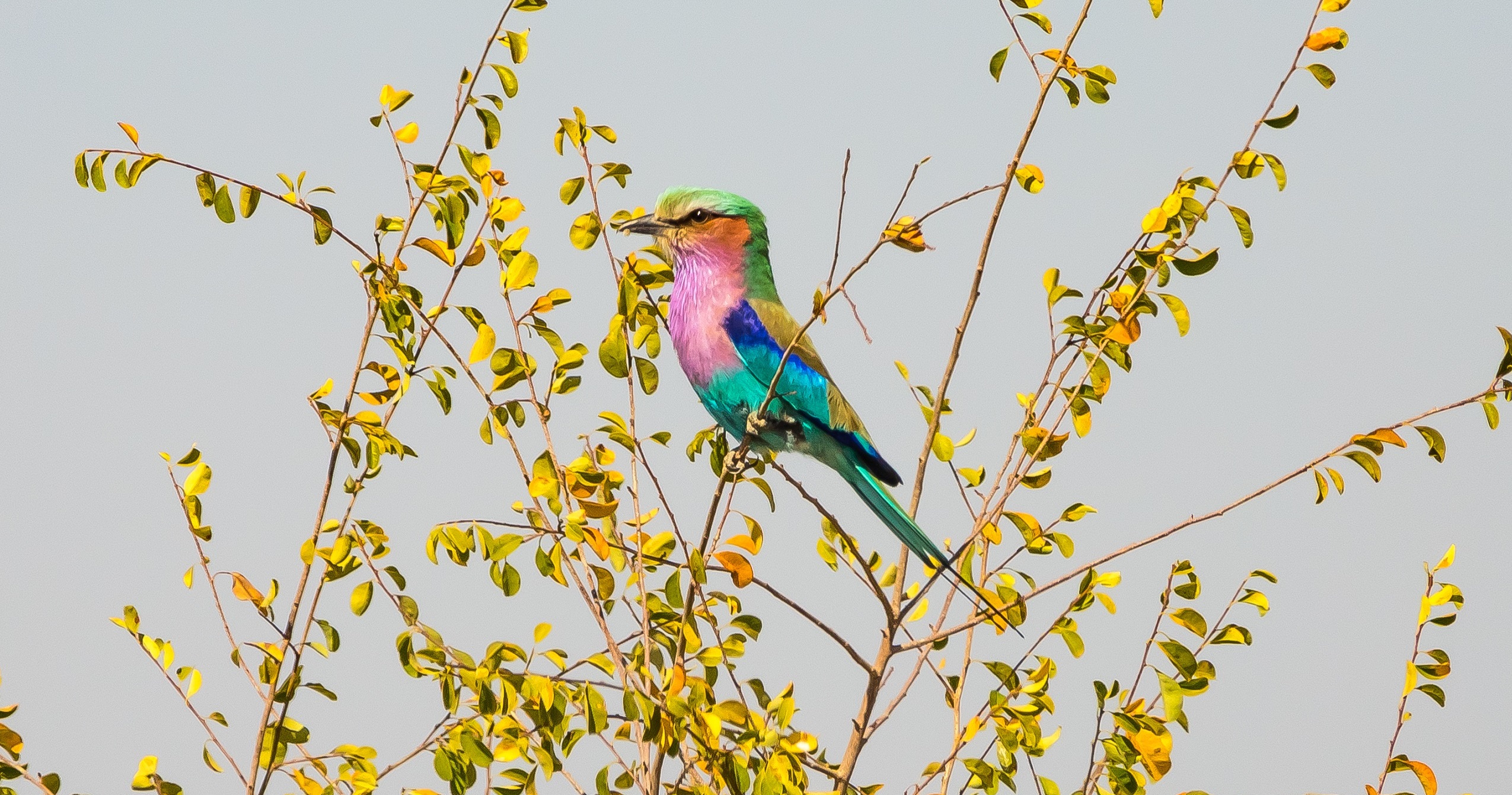
Photo Courtesy of Paul Shio
While certain animal sightings can never be promised, some that you will likely spot while on safari include buffalo, crocodiles, hippos, warthogs, and kudu, as well as a vast array of birds, like the lilac-breasted roller, which is a teeny bird so absolutely beautiful that you have to see it to believe it. I also feel pretty confident in saying that you will see enough impala to last you a lifetime – my guide joked that they are like the McDonald’s of the animal kingdom; one on every corner.
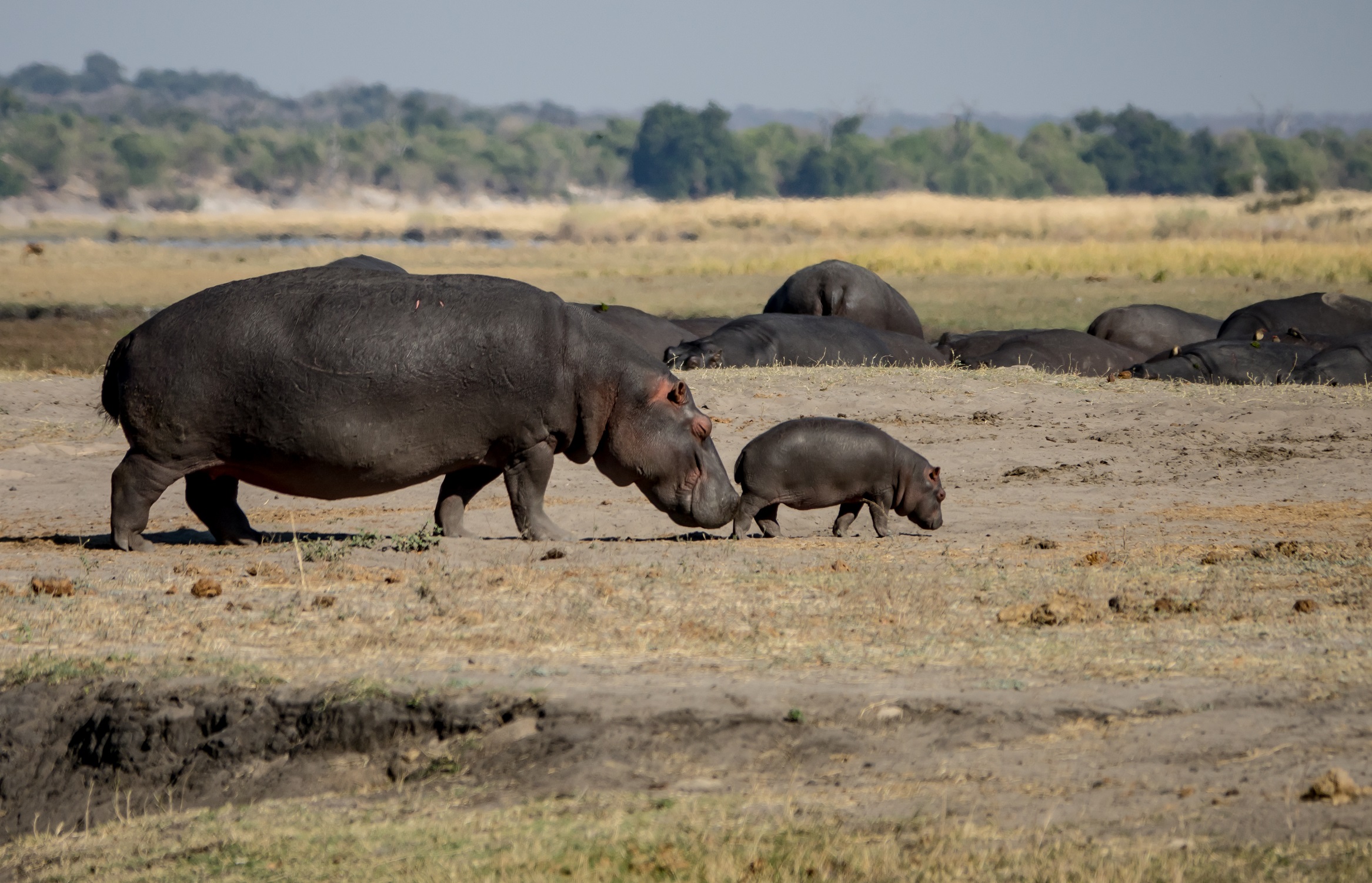
Photo Courtesy of Paul Shio
After the safari, you will jump back on the boat to have lunch at a floating restaurant on the Chobe River called The Raft, and then you are off on a longer boat safari on the Chobe and Zambezi rivers. A lot of animals head to the water to cool off later in the day, so you will get to see them from a completely different perspective than you did while in the Jeep. At one point, while we were drifting near the shore, I caught baboons, elephants, vervet monkeys, and hippos all on one quick video.

Photo Courtesy of Mila Pantovich
While staying at Cascades Lodge, you will also get to explore Impalila Island and its many villages. You will have a chance to learn about the area, meet some locals, and even buy some handmade items (my personal favorite was the little warthogs made from straw). And if anyone offers you a little round seed-like pod, try it! Actually a fruit from a local tree, its nickname is the bubble gum fruit and you chew it like you would gum. It tastes exactly like the bright pink Bubblicious gum you probably enjoyed as a kid and also like gum, you aren’t meant to swallow it.

Photo Courtesy of Paul Shio
When your time at Cascades Lodge is over, you will be flown to Kariba, Zimbabwe aboard a charter flight, and then quickly driven to the African Dream vessel on Lake Kariba. Built entirely by CroisiEurope, the African Dream combines contemporary comfort with the exotic setting of Africa. This glamorous modern houseboat was designed to give you uninterrupted views of the scenery, from the floor-to-ceiling windows in every cabin to the 360-degree sun deck on the top (this is where I spent hours every night, taking photos of the Milky Way). Beneath the sun deck is the upper deck, which is where the lounge, bar, kitchen, and restaurant can be found. There is also an exterior deck with a little pool at the stern and an outdoor dining area with lounge chairs at the bow. Then there is the main deck below that, where the vessel’s eight cabins are located, as well as the wheelhouse (which you will get to tour), and crew cabins. Each guest cabin is decorated with high-end furnishings, climate control, a private bathroom with a shower, and a television (which you will probably never use). Two of them even have little balconies that face the bow.
The African Dream has a staff of eight who take care of your every need, including an excellent chef who prepares each multiple-course meal. Food supplies are brought in from Harare, Zimbabwe every few days, and the menu is a combination of classic French cuisine (CroisiEurope is a French company, after all) and traditional African fare. The recipes were also designed by MasterChef South Africa judge Pete Goffe-Wood. Honestly, the meals on the African Dream are probably some of the best I have ever had.

Photo Courtesy of Paul Shio
Just like your time in Namibia, you will spend your days gazing at wildlife in their natural habitat, sometimes by boat and sometimes by land. Each morning you will wake up in a new area on the lake and will then board a smaller boat to go exploring.
Watched over by the river god Nyami Nyami (one of the most important gods of the Tonga people), Lake Kariba is the largest man-made lake in the world and features 293 small islands scattered throughout. Covering approximately 2,155 square feet, Lake Kariba feels more like the ocean than it does a lake. As one of the least touristy spots on the trip, you will get to experience the breathtaking landscape uninterrupted by others. The lake was filled between 1958 and 1963 after the Kariba Dam was completed, which flooded the Kariba Gorge on the Zambezi River. A rescue mission called Operation Noah was quickly orchestrated to rescue wildlife from the rising waters. More than 6,000 animals (including elephants, antelopes, rhinos, lions, zebras, lions, warthogs, and snakes) were relocated to Matusadona National Park (where hunting is strictly prohibited) and around Lake Kariba itself.

Photo Courtesy of Mila Pantovich
Because of the Kariba Gorge’s decomposing, inundated vegetation that the water flooded, the soil at the bottom of the lake is now incredibly fertile. As a result, the ecology of Lake Kariba is incredibly vibrant. Not only does the lake support a thriving commercial fishery, it is also home to crocodiles and hippos (there is one area where you are literally surrounded by hundreds of them!). You will also likely see countless bird species, like fish eagles, cormorants, and other water birds, as well as elephant herds and buffalo. Who knows, you might even catch sight of some lions cooling off on the shoreline.
Scattered throughout the perimeter where the lake is the most shallow are hundreds upon hundreds of skeletal trees that died when the area was flooded. Referred to as drowned trees, their bare branches reach up, silhouetted by the lake and sky. If you think you have seen a beautiful sunset, just wait.

Photo Courtesy of Mila Pantovich
You will have your second safari drive in the aforementioned Matusadona National Park, which will feel a lot more wild and untouched than Chobe National Park. In fact, during the entire safari, we only saw two other vehicles. The animals also seem more shy there, which really drives home the fact that you are in their world and you must respect it.
Matusadona was proclaimed a non-hunting area in 1958, long before it became a national park in 1975. Because of its proximity to Lake Kariba, the park has seen a marked increase in the population of large animals, like elephants, Cape buffalo, waterbuck, zebra, and impala. And of course, their predators. The park is also considered an Intensive Protection Zone (IPZ) and is home to several relocated rhinoceros, though I never caught sight of any on this trip – I was told that unfortunately, most rhinos are now in Zambia.
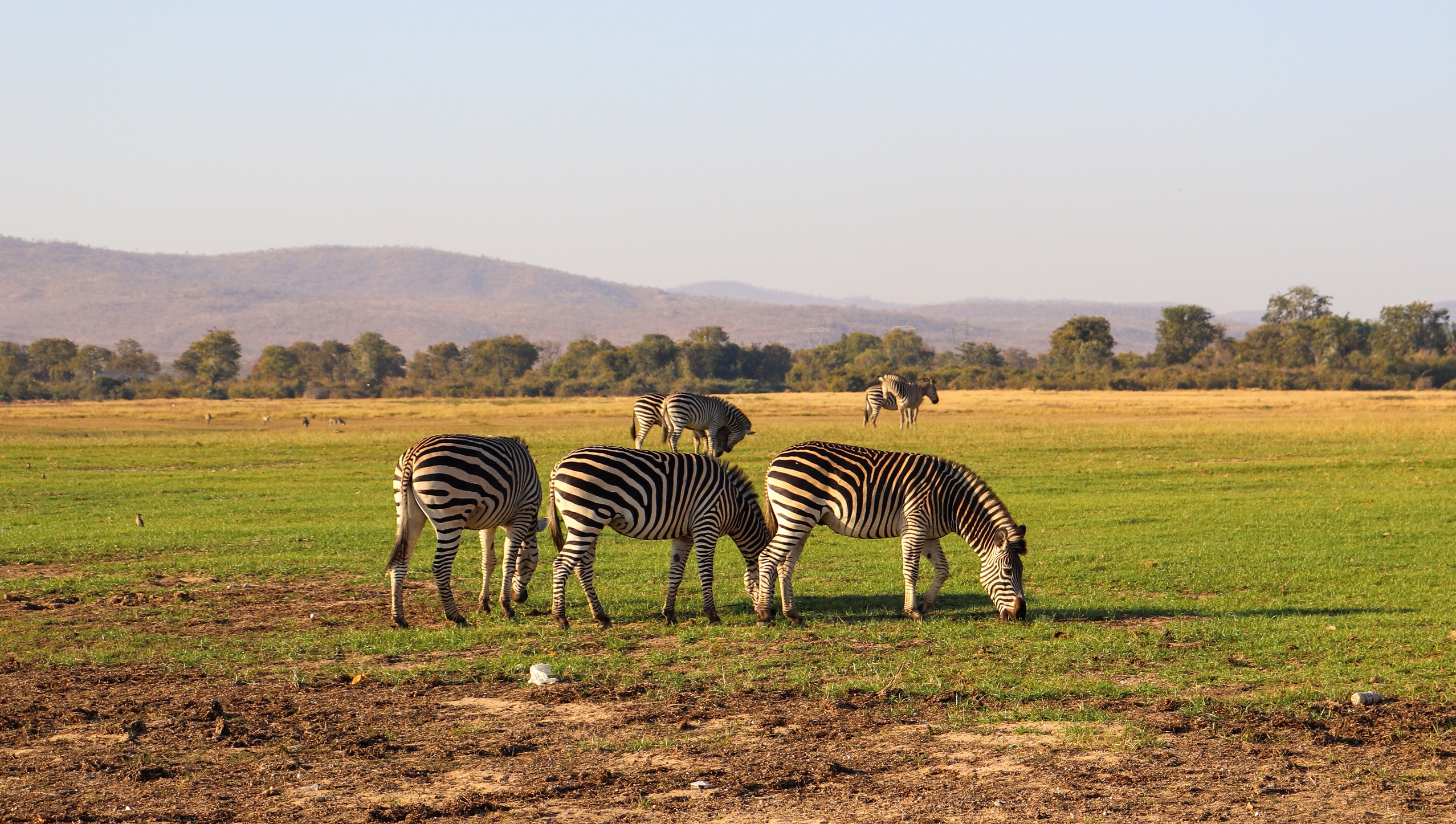
Photo Courtesy of Mila Pantovich
Though I didn’t see as many animals in Matusadona as I did in Chobe, it was still remarkable. Not only did we learn a lot from our local guide (including a fascinating story on how the acacia tree can become bitter to taste in order to protect itself from becoming consumed by elephants), we found ourselves in the middle of a massive elephant parade making their way down to the water, and even spotted a herd of zebra. Once we were back on the little transfer boat, we explored that area I mentioned that is full of crocodiles and hippos, spotted countless black herons, yellow-billed storks, wire-tailed swallows, and even spotted the rarely seen african skimmer.
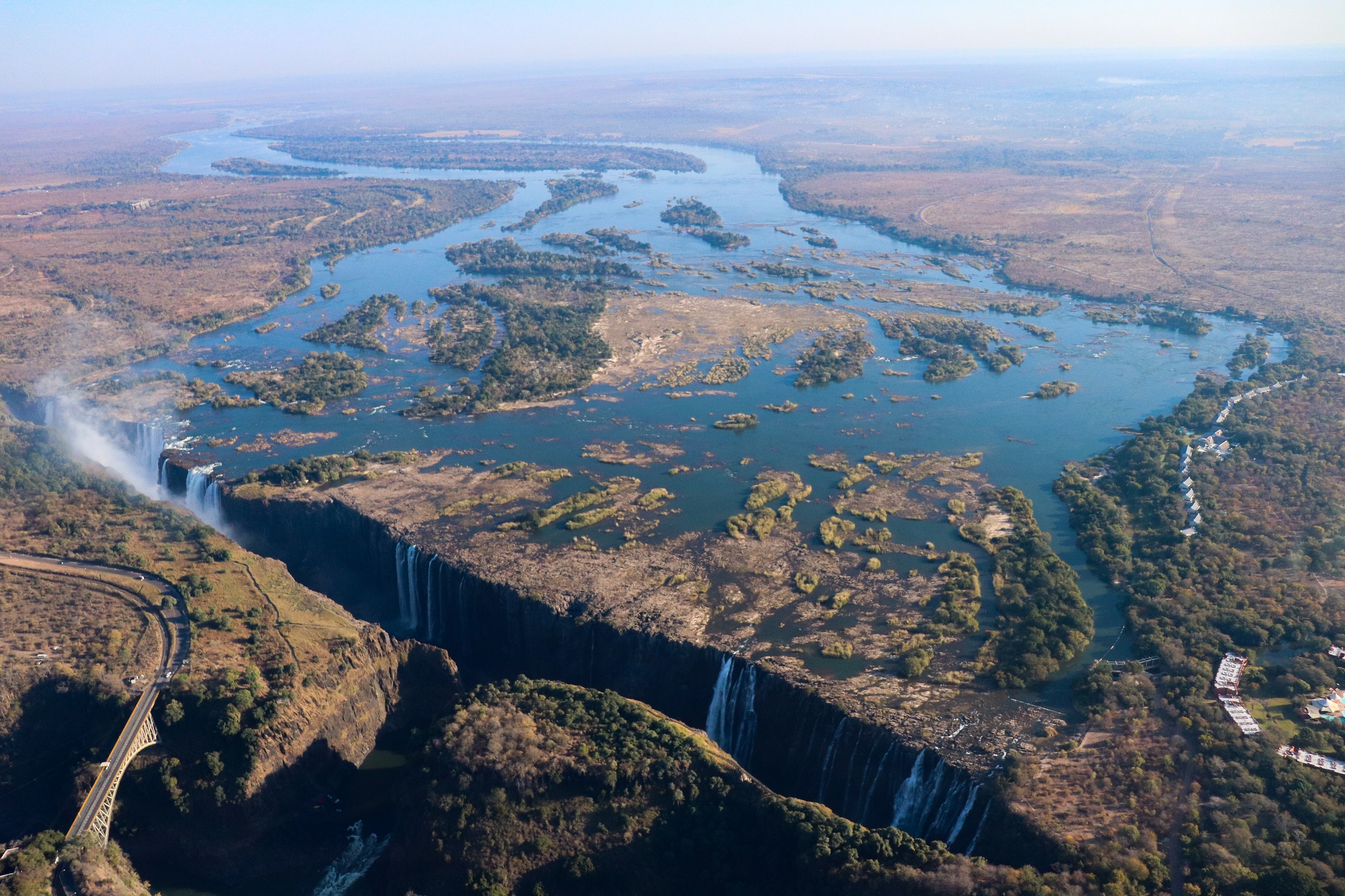
Photo Courtesy of Mila Pantovich
The trip, unfortunately, ends in the town of Victoria Falls, where you will first check in to the Victoria Falls Safari Lodge. Offering unobstructed views of the African bush, including a watering hole that animals frequent every morning and night, the hotel is designed to resemble an open treehouse. There are three different room types to choose from – the Lodge Standard Room, the Lodge Waterhole Facing Room and the Lodge Waterhole Facing Suites – but no matter which one you end up getting, it will be spacious and light.
After checking in, you will have a pleasant lunch on a riverboat while cruising down the Zambezi River, before heading to the Victoria Falls waterfall to explore on foot (though you will have the opportunity to add an optional helicopter tour of the falls for your last morning, which I highly recommend).

Photo Courtesy of Paul Shio
Attracting around one million visitors per year, Victoria Falls was described by the Kololo tribe living in the area in the 1800s as “Mosi-oa-Tunya” – meaning, “The Smoke that Thunders.” Nowadays, the Falls is known as the greatest curtain of falling water in the world and though it isn’t the highest or widest, it is still classified as the largest, which is based on its combined width of 5,604 feet and height of 354 feet. As the world’s largest sheet of falling water, Victoria Falls is around twice the height of North America’s Niagara Falls and more than twice the width of Horseshoe Falls. Needless to say, experiencing the Falls in person is remarkable.

Photo Courtesy of Paul Shio
Victoria Falls can be enjoyed from both Zimbabwe and Zambia, since it is on the border between the two countries. In fact, the famous Devil’s Pool can only be accessed from the Zambia side of the Falls and requires you to hop into the river upstream, get pushed downstream by the raging waters, only to be halted by the rock’s edge that keeps you from the drop only a few feet away. Though Devil’s Pool isn’t on the itinerary, you can easily add an extra day or two onto your trip if you want to try it out on your own time.
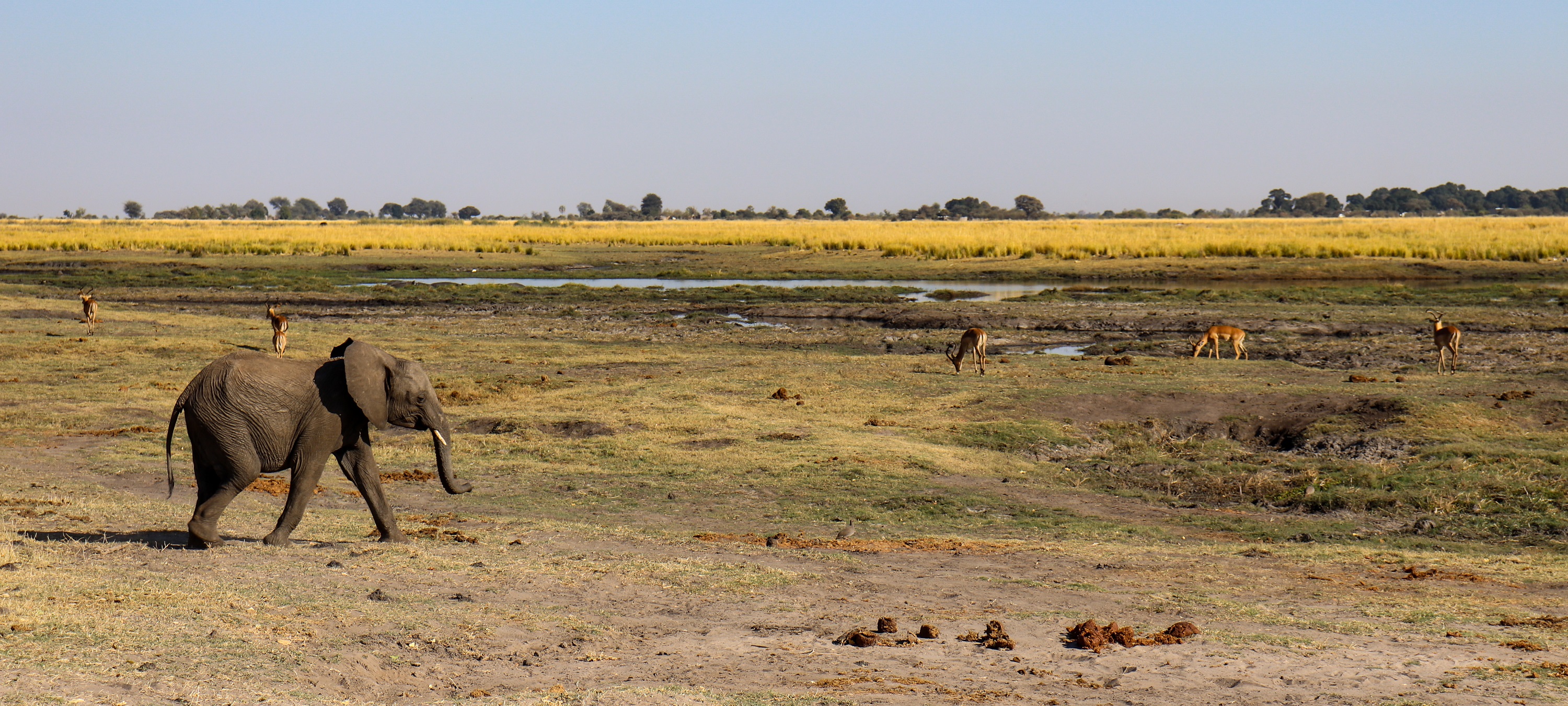
Photo Courtesy of Mila Pantovich
By the time the trip ended, I felt like this surreal experience had become my real life and the thought of returning home was more than a little heartbreaking. After all, how was I supposed to go back to a life where I didn’t spend my mornings watching baby elephants trotting along beside their mothers, trying to stay on their feet? Where I didn’t spend my afternoons drifting along Lake Kariba, drinking sparkling water and watching hippos bob up and down in front of me, ears wiggling? It’s been three weeks and honestly, I still don’t know. All I know is that I will definitely be back.

Photo Courtesy of Mila Pantovich
A few notes:
- Though the Cascades Lodge has very strong Wi-Fi, the African Dream on Lake Kariba does not, so you might want to use this trip as an excuse to completely unplug.
- CroisiEurope will insist that you have five open pages in your passport for this trip and you legitimately need it. Because of where the CroisiEurope lodge in Namibia is, you will become very well acquainted with the immigration offices in Botswana and Namibia. And that isn’t even counting South Africa and Zimbabwe!
- Take the baggage restrictions seriously. You will take two charter flights and the planes have very limited allowances. If your bag even looks too big or too heavy, you might have a problem.

Photo Courtesy of Mila Pantovich
- You don’t really need to order any foreign currency as long as you have a credit card for any shop-based shopping you might want to do in South Africa, and plenty of US cash for tipping and cash-based shopping you want to do in Namibia, Zimbabwe, and Botswana.
- Lastly, if you don’t have a decent camera, you might want to invest in something. You are going to wish you had one when you spot zebras just a little farther away than your iPhone can zoom. I have a Canon EOS Rebel T7i and it did the trick, for the most part.
- For the full itinerary, since I only touched on the highlights, check out CroisiEurope’s website.

Photo Courtesy of Mila Pantovich

Photo Courtesy of Mila Pantovich
